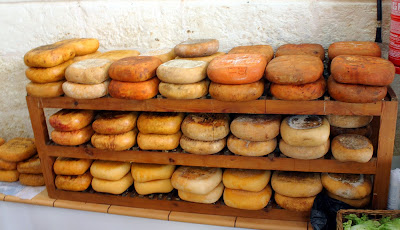Two weeks today we returned from our Menorcan holiday. Since then I’ve barely got out birding due to a combination of domestics and dreary, windy and often wet weather. To put the record straight, Another Bird Blog is very much alive and well and will soon be back to normal. In the meantime, here are yet more pictures from Menorca.
Hoopoes seemed rather scarce this year. Even the ones which feed in the hotel grounds without fail were not seen on their usual daily basis. Mostly we caught glimpses of roadside birds or heard their unmistakeable “hoop-hoop” calls from the countryside. Like lots of Menorcan birds, the Hoopoe isn't especially easy to see.
Hoopoe
Bee Eaters were scarce too. Perhaps with the fine weather the island had enjoyed for weeks beforehand we’d missed many migrant birds which pass through our regular viewing spot. Then a day or two later when we looked again there were workmen digging up the road, laying pipes alongside the breeding colony and very few Bee Eaters using the fence where they sit between feeding forays. Maybe Bee Eaters don’t have the same degree of protection as they do in the UK but even so to be undertaking major highway work adjacent to breeding Bee Eaters would seem to very irresponsible.
Bee Eater
Happier times were had at Es Grau where a single Whiskered Tern fed over the water and Black-winged Stilts had good sized juveniles. One or two late adults were still sitting closely on eggs.
Es Grau
Black-winged Stilt
Black-winged Stilt
Whiskered tern
Es Grau is a good place to find Pied and Spotted Flycatchers, Sardinian Warblers, Cetti's Warblers and Turtle Doves. Our botanist and birding companions for the day, Jane and Alan were hugely excited by their find of three specimens of Sawfly orchid Ophrys tenthredinifera. “A terrible photograph - stick to birds Phil”
Turtle Dove
Sawfly orchid
We stopped at picturesque Fornells for the mandatory coffee where from the outdoor café we watched an Osprey circle over the shallow waters. The Osprey drifted off to look elsewhere and we set off for Addaia.
Fornells - Menorca
Amongst the Shelduck, Oystercatcher, Avocet, Greenshanks, Ringed Plovers and Little Ringed Plovers at Addaia there was a single unexciting juvenile and un-pink Flamingo.
Greater Flamingo
The (Greater) Flamingo Phoenicopterus roseus is the most widespread species of the flamingo family. It is found in parts of Africa, southern Asia, Israel, and southern Europe. Although the species doesn’t breed in Menorca the ones that appear on the island during the winter and into Spring are probably short-distance migrants from the breeding populations of Southern Spain and the French Camargue.
As usual there were one or two very flighty Wood Sandpipers about Addaia. But the not too good pictures below were taken at the local sewage works at Es Migjorn where a Common Sandpiper gave good comparison views. Yes folks, even on a Menorca holiday a birder must visit the sewage works.
It’s rather like the old Northern expression “Where there’s muck there's brass” but slightly adapted to read “Where there’s muck there’s birds”.
Wood Sandpiper and Common Sandpiper
Wood Sandpiper
Tomorrow is news and views from Oakenclough when I meet up with Andy for a peek into the nest boxes. Let’s hope the news isn’t too bad although by all accounts so far from other regions, the early season has been poor.
Linking today to Anni's Blog and Eileen's Saturday Blog.
Linking today to Anni's Blog and Eileen's Saturday Blog.



































































.jpg)














